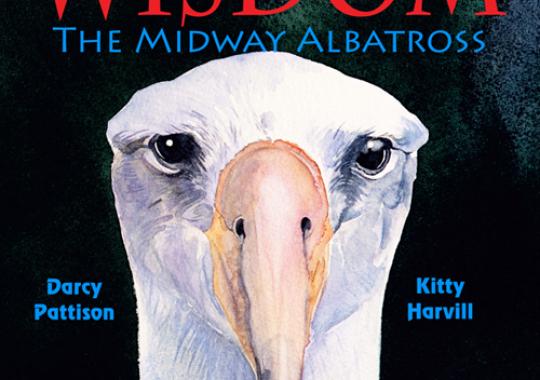WISDOM, THE MIDWAY ALBATROSS: Surviving the Japanese Tsunami and other Disasters for over 60 Years
THE OLDEST BIRD IN THE WORLD SURVIVED THE JAPANESE TSUNAMI: Read All About It! It’s been almost a year since the March 11, 2011 earthquake off the shore of Japan which sent a tsunami wave west to overrun Tohoku, Japan. But the tsunami also traveled east and struck Midway Atoll at midnight. Nesting on Midway is the oldest known wild bird in the world. At an estimated 60 years old, she survived the tsunami. Just in time for the anniversary of the disaster, comes a book chronicling her amazing story, Wisdom, the Midway Albatross: Surviving the Japanese Tsunami and other Disasters for over 60 Years (Mims House, EPub: ISBN 9780979862182, Paperback: ISBN 9780979862175). First banded by scientist Chandler Robbins, Wisdom, a Laysan Albatross, has been re-caught and re-banded five times since then. Robbins says, "On Dec. 10, 1956, early in my first visit to Midway, I banded 99 incubating Laysan Albatrosses in the 'downtown' area of Sand Island, Midway. One of these 99 birds, called Wisdom (band number 587-51945) is still alive, healthy, and incubating again in December 2011. While I have grown old and gray and get around only with the use of a cane, Wisdom still looks and acts just the same as on the day I banded her." Wisdom was presumed to be five years old in 1956, the earliest age at which Laysan Albatrosses breed. Since then, she has survived numerous disasters including tsunamis, tropical storms, hurricanes, longline fishing and plastic pollution. Longline fishing is the practice of baiting lines of hooks several miles long. When a seabird tries to catch and eat the bait, it becomes entangled in the lines and almost always dies. The fishing industry has modified its practices by tying colorful ribbons to the line to frighten the birds and by modified hooks which are harder for birds to catch from above. Plastic pollution occurs because seabirds land on the water to eat and don't distinguish real food from floating bits of plastic. On Midway, many albatrosses and chicks die each year because they eat so much plastic their stomachs are too full and there's no room for food: they starve to death. Wisdom wears a bright red leg band now, Z333, which makes her easy to spot from a distance. This December, scientist on Midway watched anxiously for her return. About mid-December, she was spotted and she had already laid another egg. It is suspected that in her lifetime, she has raised 30-35 chicks. Now, at 61, she is waiting for another chick. Conservation efforts for the Laysan Albatrosses and other seabirds took an upturn in 1993 when the naval station on Midway Island was closed and it became a National Wildlife Refuge, bring seabird populations to an all-time high. Still, natural and manmade dangers take a yearly toll: winter storms often overrun the narrow, low-lying island; stomachs full of plastic mean starvation for hundreds; fishing is still a danger; and of course, there are always the natural predators, the sharks. Wildlife artist Kitty Harvill and children's book author Darcy Pattison have teamed up to tell Wisdom's story. "It's a story that had to be told," Pattison says. Harvill echoes that sentiment and adds, "When I started looking at photographs of Wisdom, I fell in love with this bird and wanted to bring her story to kids from around the world." For more on the book, see albatross.darcypattison.com. For more on the illustrations, see facebook.com/KittyHarvill Early comments about the book: • “Wisdom's story makes my heart soar.” --Kirby Larson, author of Two Bobbies: A True Story of Hurricane Katrina, Friendship and Survival and Newbery Honor medalist for Hattie Big Sky • “The remarkable story of Wisdom the 60-year-old Laysan Albatross will help educate young people to the plight of albatrosses, and encourage them to help save them. You can read more about the conservation of albatrosses at www.acap.aq.” --John Cooper, Information Officer, Agreement on the Conservation of Albatrosses and Petrels Wisdom’s story is already finding its place among bird lovers. Other acclaim for the book comes from wildlife biologists, especially those who specialize in seabirds. • “On December 10, 1956, early in my first visit to Midway, I banded 99 incubating Laysan Albatrosses in the ‘downtown’ area of Sand Island, Midway. Wisdom (band number 587-51945) is still alive, healthy, and incubating again in December 2011. While I have grown old and gray and get around only with the use of a cane, Wisdom still looks and acts just the same as on the day I banded her. . . remarkable true story. . . beautifully illustrated in color.” Chandler S. Robbins, Sc.D, Senior Scientist (Retired), USGS Patuxent Wildlife Research Center, Laurel, MD. • “As both a seabird conservationist and a mom to young kids, I highly recommend Wisdom, the Midway Albatross. Wisdom’s true story of survival is exciting and artist Kitty Harvill brings her to life in illustrations that are beautiful and accurate. Having worked to protect these magnificent creatures, I find it wonderful to be able to share their story through this book!” Jessica Hardesty Norris, Ph.D., Seabird Program Director, American Bird Conservancy • “It’s marvelous! I LOVE it! And I got a lump in my throat, tears! And I’m a biologist! Your book is beautiful, meaningful, simple, elegant………thank you for caring, thank you for sharing this story!” Kim Rivera, National Seabird Coordinator, NOAA Fisheries, Deputy ARA, Protected Resources Division, Alaska Region Wisdom has a Facebook page, sponsored by the US. Fish and Wildlife Services, where you can follow the news about her and her 2012 chick: http://www.facebook.com/wisdomthealbatross For more on the book that tells her story, see http://albatross.darcypattison.com

- Login to post comments
-


